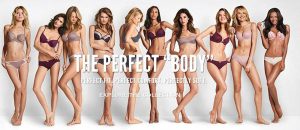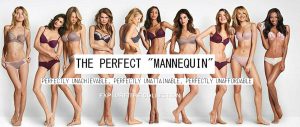Welcome to UBC Blogs. This is your first post. Edit or delete it, then start blogging!
Culture Jam Assignment – Victoria’s Secret Perfect “Body”

The “perfect” “body” – the slogan on Victoria’s Secret’s lingerie wear advertisement in 2014 – seems to be a problematic sentence on its own, and especially paired with the models displayed on the poster. The word perfect, used in a descriptive sense, could be highly subjective under many circumstances, and nearly impossible to define in terms of describing the human body – women’s bodies in this instance. The most concerning issue depicted through this particular marketing campaign is that it attempts to define what a perfect women’s bodies should look like using images of models with highly unrealistic body features, further enhanced via professional photo editing skills. Moreover, aside from the unrealistic features of the models, the body type, race, physical condition, age, and the general vibe of the models portray an extremely narrow cohort of women in society. Precisely, the models displayed in the poster are young, able-bodied, thin, and most likely western women, varying within two different races at most.
Studies of class and race feminism could also be used to further analyze the theme of this advertisement. As this campaign was primarily launched to sell lingerie wear, that could help achieve the look of the “perfect body,” which, in turn, could be translated that women who don’t wear such articles of clothing cannot achieve the perfect body. Moreover, considering that most of the undergarments sold by the brand are on the more expensive price range, definitely not all women in society could afford them, thus potentially marginalizing some women in terms of achieving the “perfect body” that this advertisement promotes – this could lead to further marginalization of certain cohorts of women that are marginalized already due to economic and social circumstances. Furthermore, social cues presented by the advertisement show superiority of the status achieved by obtaining and showcasing such undergarments, which further polarizes the status of economic and social classes of women. Overall, the main issue of concern regarding this piece of advertisement is the attempt to define the way a women’s body should resemble, and the disparity it creates between modeled images vs. reality, and the exacerbation of polarization between women of different economic and social groups in regards to the ability to support the idea of the type of lifestyle illustrated through the advertisement.

The newly modified image of the Victoria’s Secret advertisement is intended to display the underlying meanings that the advertisement projects subtly behind the intended marketing content of the product. I’ve inserted the new catch phrase The Perfect “Mannequin” in the place of the previous slogan The Perfect “Body.” As per the analysis of the original image, the usage of the word Perfect in a descriptive manner in conjunction to the word body is highly subjective and an appropriate definition is unachievable. Furthermore, the discrepancy between the slogan and the actual consumer population is exacerbated by the highly limited representation of race, body type, and possible indication of socioeconomic status of the models displayed on the advertisement. Additionally, the indication of the socioeconomic status is more so exemplified by the high price range of the product itself, rather than the actual images portrayed on the advertisement. However, the idea of it further advocates the disparity between reality of women and the ideals portrayed via the context of the advertisement that triggers the idea that the products marketed is essential in order to obtain the status of the perfect body. Therefore, underneath the new catch phrase are the new sub premises to support the notion that the intended context of the original advertisement is quite simply, unachievable, unattainable and in many cases, unaffordable.